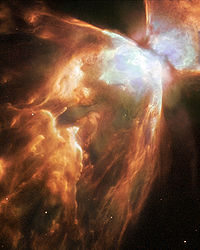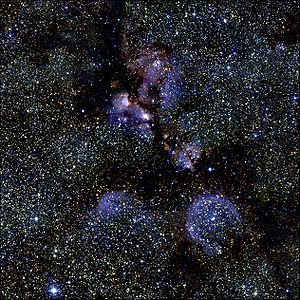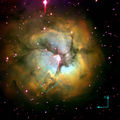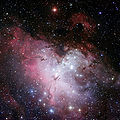
Gum catalog
Encyclopedia
The Gum catalog is an astronomical catalog
of 84 emission nebula
e in the southern sky. It was made by the Australia
n astronomer
Colin Stanley Gum
(1924-1960) at Mount Stromlo Observatory
using wide field photography. Gum published his findings in 1955 in a study entitled A study of diffuse southern H-alpha nebulae which presented a catalog of 84 nebulae or nebular complexes. Similar catalogs include the Sharpless catalog
and the RCW catalog, and many of the Gum objects are repeated in these other catalogs.
The Gum Nebula
is named for Gum, who discovered it as Gum 12; it is an emission nebula
that can be found in the southern constellation
s Vela
and Puppis
.
Astronomical catalog
An astronomical catalog or catalogue is a list or tabulation of astronomical objects, typically grouped together because they share a common type, morphology, origin, means of detection, or method of discovery...
of 84 emission nebula
Emission nebula
An emission nebula is a cloud of ionized gas emitting light of various colors. The most common source of ionization is high-energy photons emitted from a nearby hot star...
e in the southern sky. It was made by the Australia
Australia
Australia , officially the Commonwealth of Australia, is a country in the Southern Hemisphere comprising the mainland of the Australian continent, the island of Tasmania, and numerous smaller islands in the Indian and Pacific Oceans. It is the world's sixth-largest country by total area...
n astronomer
Astronomer
An astronomer is a scientist who studies celestial bodies such as planets, stars and galaxies.Historically, astronomy was more concerned with the classification and description of phenomena in the sky, while astrophysics attempted to explain these phenomena and the differences between them using...
Colin Stanley Gum
Colin Stanley Gum
Colin Stanley Gum was an Australian astronomer who catalogued emission nebulae in the southern sky at the Mount Stromlo Observatory using wide field photography. Gum published his findings in 1955 in a study entitled A study of diffuse southern H-alpha nebulae which presented a catalog, now known...
(1924-1960) at Mount Stromlo Observatory
Mount Stromlo Observatory
Mount Stromlo Observatory located just outside of Canberra, Australia, is part of the Research School of Astronomy and Astrophysics at the Australian National University .-History:...
using wide field photography. Gum published his findings in 1955 in a study entitled A study of diffuse southern H-alpha nebulae which presented a catalog of 84 nebulae or nebular complexes. Similar catalogs include the Sharpless catalog
Sharpless catalog
The Sharpless catalog is a list of 312 HII regions , intended to be comprehensive north of declination -27°. The first edition was publishing 1953 with 142 objects and second and final version was published by US astronomer Stewart Sharpless in 1959 with 312 objects.In 1953 Stewart Sharpless joined...
and the RCW catalog, and many of the Gum objects are repeated in these other catalogs.
The Gum Nebula
Gum Nebula
Gum Nebula is an emission nebula that can be found in the southern constellations Vela and Puppis. It lies roughly 400 parsecs from the Earth. Hard to distinguish, it is believed to be the greatly expanded remains of a supernova that took place about a million years ago...
is named for Gum, who discovered it as Gum 12; it is an emission nebula
Emission nebula
An emission nebula is a cloud of ionized gas emitting light of various colors. The most common source of ionization is high-energy photons emitted from a nearby hot star...
that can be found in the southern constellation
Constellation
In modern astronomy, a constellation is an internationally defined area of the celestial sphere. These areas are grouped around asterisms, patterns formed by prominent stars within apparent proximity to one another on Earth's night sky....
s Vela
Vela (constellation)
Vela is a constellation in the southern sky. Its name is Latin for the sails of a ship, and it was originally part of a larger constellation, the ship Argo Navis, which was later divided into three parts, the others being Carina and Puppis.-Stars:...
and Puppis
Puppis
Puppis is a constellation in the southern sky. Its name is the Latin word for the poop deck of a ship, and Puppis represents the deck of the ship and its deckhouses...
.
Examples
Examples from the Gum Catalog (1955); click on image for image credit, most of which are either various amateur astronomers, the ESO, ESA, or NASA| Gum | A common name | Images | Names & Designations |
|---|---|---|---|
| Gum 4 | NGC 2359 NGC 2359 NGC 2359 is an emission nebula in the constellation Canis Major. The nebula is approximately 15,000 light-years away and 30 light years in size. Known as a Wolf-Rayet star, the central star is an extremely hot giant thought to be in a brief, pre-supernova stage of evolution... |
 |
Thor's Helmet, Gum 4, Sharpless 298, NGC 2359 |
| Gum 29 | RCW 49 RCW 49 RCW 49 is a nebula located 13,700 light years away. It is a dusty stellar nursery that contains more than 2,200 stars and is about 350 light years across.-External links:* *... |
Gum 29, RCW 49 | |
| Gum 60 | NGC 6302 NGC 6302 NGC 6302 is a bipolar planetary nebula in the constellation Scorpius. The structure in the nebula is among the most complex ever observed in planetary nebulae... |
 |
Sh2-6, NGC 6302, Bug Nebula, PK 349+01 1, Butterfly Nebula, RCW RCW Catalogue The RCW Catalogue is an Astronomical catalogue of Hα-emission regions in the southern Milky Way, described in . It has 180 objects and includes many of the earlier Gum Catalog objects, and the later Caldwell catalogue included some RCW... 124, Caldwell Caldwell catalogue The Caldwell Catalogue is an astronomical catalog of 109 bright star clusters, nebulae, and galaxies for observation by amateur astronomers. The list was compiled by Sir Patrick Caldwell-Moore, better known as Patrick Moore, as a complement to the Messier Catalogue.The Messier Catalogue is used... 69 |
| Gum 64 | NGC 6334 NGC 6334 NGC 6334 is an emission nebula located in the constellation Scorpius. It was discovered by astronomer John Herschel in 1837, who observed it from the Cape of Good Hope in South Africa.-External links:* — ESO Photo Release*Astronomy Picture of the Day - 2010 April 21... |
 |
ESO 392-EN 009, Sharpless 8, RCW 127, Gum 64, NGC 6334 |
| Gum 66 | NGC 6357 NGC 6357 NGC 6357 is a diffuse nebula near NGC 6334 in the constellation Scorpius. This nebula was given the name War and Peace Nebula by the Midcourse Space Experiment scientists because of its appearance. They said that in infrared images the bright, western part resembles a dove, while the eastern part... |
 |
Sh2-11, NGC 6357, RCW 131, Gum 66, War and Peace Nebula |
| Gum 72 | Lagoon Nebula Lagoon Nebula The Lagoon Nebula is a giant interstellar cloud in the constellation Sagittarius. It is classified as an emission nebula and as an H II region.... |
Sh2 25, RCW 146, Gum 72, Messier 8 | |
| Gum 76 | Trifid Nebula Trifid Nebula The Trifid Nebula is an H II region located in Sagittarius. Its name means 'divided into three lobes'... |
 |
Sh2 30, M20, NGC 6514, RCW 147, Gum 76 |
| Gum 81 | Omega Nebula Omega Nebula The Omega Nebula, also known as the Swan Nebula, Checkmark Nebula, Lobster Nebula, and the Horseshoe Nebula is an H II region in the constellation Sagittarius. It was discovered by Philippe Loys de Chéseaux in 1745. Charles Messier catalogued it in 1764... |
 |
Omega Nebula, M17, NGC 6618, Swan Nebula, Sharpless 45, RCW 160, Gum 81 |
| Gum 83 | Eagle Nebula Eagle Nebula The Eagle Nebula is a young open cluster of stars in the constellation Serpens, discovered by Jean-Philippe de Cheseaux in 1745-46. Its name derives from its shape which is resemblant of an eagle... |
 |
Sh2 49, Messier 16, NGC 6611, RCW 165, Gum 83 |
List
|
RCW 49 RCW 49 is a nebula located 13,700 light years away. It is a dusty stellar nursery that contains more than 2,200 stars and is about 350 light years across.-External links:* *... |
|
|
Sources
- Gum Nebula
- SouthernSkyPhoto.com
- Anglo-Australian Observatory
- Physics Today, 2001
- The Cloud Hunters
- Illustrated Gum Catalog

